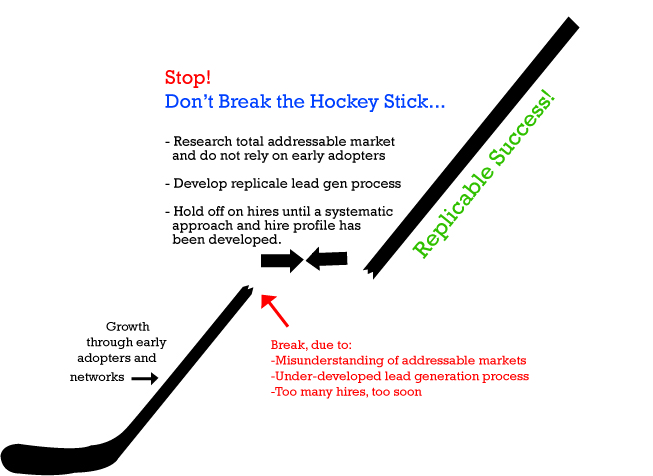We’d all like to see that swooping, hockey stick incline in revenue when we’re ramping up our startups.
But more often than not, the hockey stick breaks, and revenue stalls at some point in the growth process. This trend is a daunting reality for startup founders, and one that they would obviously like to avoid.
We’ve identified the common mistakes that cause tension on that hockey stick growth until it inevitably snaps — and how to avoid making them.
You don’t understand your total addressable market.
Do not mistake early adopters for the majority.
The first people who use your product are typically aggressive users of technology, who make conscious efforts to stay ahead of the crowd. This automatically makes them different than the average user in your total addressable market.
You want to get past the early adopters, to the “pragmatists in pain”. This population, as Geoffrey Moore describes in his sales staple, Crossing the Chasm, is made up of buyers who are stuck with a business problem, and they’re willing to try something new to fix it. They may not seek you out like the early adopters, but if you can connect with them on the problem they’re facing and present the obvious solution in what you’re offering, they will likely give it a try.
“Most companies are not specific enough in their customer targeting,” said Aaron Ross in an interview with Inc. Magazine. “You want to be a big fish in a small pond.”
Finding and understanding these small ponds, rather than allowing your early adopters to define your market, is critical. If you ramp based on growth with the early adopters, before “crossing the chasm” to the “pragmatists in pain”, your market will dry up quickly and that hockey stick will snap.
But don’t stop there.
Keep testing new markets to identify as many small ponds as possible. Do your research, test, and run with it when you find the perfect fit.
You don’t have a repeatable lead generation process.
Lead generation should run like a marathon — not interval sprints. A steady, rhythmic process is essential in filling the pipeline and avoiding a sudden dry well.
You’ll need a combination of inbound and outbound efforts, with an awareness that not all leads are equal.
Your business should skew towards one side, depending on your target audience. If your product costs less than $300 a month, you should not be making outbound calls in 99% of cases. Conversely, if you’re only targeting large enterprises, you should be using a mix of direct outreach and content. Social media and blogging are great, but until you’re seeing proven ROI, don’t depend too heavily on these types of leads.
Ross provides a handy infographic on his Predictable Revenue blog, illustrating the efficiency of different generation methods. His calculations place outbound leads at the top and social media at the very bottom.
Systemizing your lead generation process will make everything easier down the line, from predicting revenue to making hires. Activate and master the programs you’ll use in your lead generation process as soon as possible.
Your board tells you to keep hiring…and you do.
There’s an unfortunate attitude amongst investors that more bodies equals more money.
But ramping up too quickly is the ultimate downfall of most startups. Both founders and investors tend to jump the gun at the first sign of success, but a core network and early adopters often create inflated results at this stage. This misguided sense of confidence leads to unwarranted acceleration — working the hockey stick too hard, too fast.
Then the network dries up, and the early adopters become distracted by something even newer. You’re left with too many people and not enough business to go around.
Another problem is that you’ve yet to perfect your hiring profile. When you haven’t been selling for long, it’s difficult to identify who else can sell for you. You’ll eventually need a system and process for interviewing that will increase the chances of a successful hire. Until you’ve developed these, your hiring process is based on gut alone — which is rarely a reliable source.
A perfect example of this setback comes from Ameet Ranadive in an article on Medium where he describes a pivotal moment for his startup.
“Here were some really experienced investors who themselves had been CEOs of companies in the past, and they were telling us with a lot of confidence that we had an execution problem that would be fixed if we hired more salespeople,” describes Ranadive.
He goes on to explain how his startup’s burn rate grew dramatically, it became difficult to pivot, and their cash was depleted — all because they took their investors’ advice and hired more salespeople.
Turns out, as is usually a case, Ranadive and his team didn’t have an execution problem, like their investors predicted. They had a market problem. “We really should have kept our team lean and focused on solving the market problem.”
The solution? Plan, run, adjust, repeat.
Avoiding these common pitfalls is going to require constant evaluation and re-evaluation. The “Plan, Run, Adjust, Repeat” model ensures that you’re constantly observing your outcomes and adjusting your processes.
Plan: Lay out a detailed game plan for lead generation and sales.
Run: Work hard to carry out your plan and track the results.
Adjust: Take the results into account when re-evaluating your plan and adjust accordingly.
Repeat: Run again!
These adjustments will allow you to avoid defining your total addressable market by the first early adopters. It will help you gradually perfect your lead generation process until it’s an efficient machine of potential. And, it will make it clearer when hiring is in fact, the right option.
Has your startup faced the broken hockey stick? How did you fix it — or even better, avoid it altogether?





